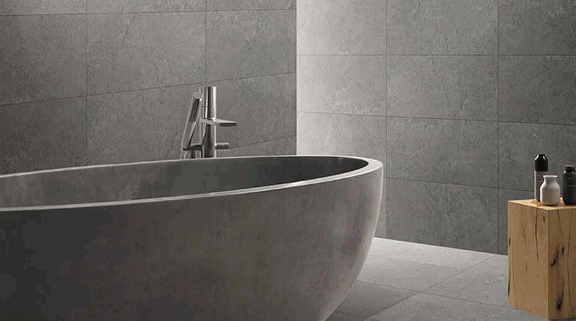Are you wondering what type of plaster is best for your bathroom?
We explore the different types of plaster used in bathrooms, including cement, gypsum, lime, and acrylic plaster.
Discuss the importance of using the right type of plaster to prevent water damage and mold growth, highlighting the benefits of water-resistant, mold-resistant, and damp-proof plaster in bathrooms.
Learn how to choose the right plaster for your bathroom to improve its aesthetics and longevity.
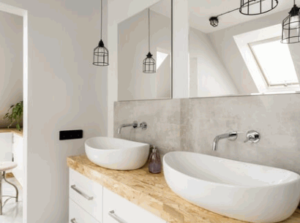
What Is A Bathroom Plaster?
Bathroom plaster refers to the material used to coat and finish the walls and surfaces in a bathroom, providing both a protective and decorative layer.
This specialized plaster is essential for sealing the walls against moisture and humidity exposure in a bathroom environment. The primary purpose of bathroom plaster is to create a waterproof barrier that prevents water damage while also enhancing the aesthetic appeal of the space.
Tadelakt and Venetian plaster are popular types of bathroom plaster known for their durability and luxurious finishes. Applying bathroom plaster involves a meticulous process of layering and smoothing the mixture onto the walls, often blending traditional techniques with modern tools for a seamless result.
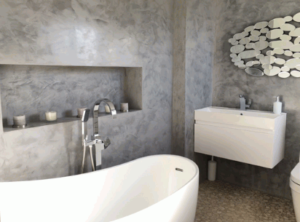
Why Is It Important To Use The Right Type Of Plaster In Bathrooms?
Using the correct type of plaster in bathrooms is crucial to ensure water resistance, durability, and maintenance of a clean and aesthetically pleasing environment.
One of the key aspects to consider when selecting bathroom plaster is its waterproofing capabilities. This feature helps create a barrier against moisture, preventing it from seeping into walls and causing structural damage. Choosing a plaster with mold and mildew resistance properties can significantly reduce the chances of these unsightly and potentially harmful growths appearing in the bathroom. Properly applied grout and durable finishes further enhance the longevity of the surfaces, ensuring that your bathroom remains both functional and visually appealing for years to come.

What Are The Different Types Of Plaster Used In Bathrooms?
Various types of plaster are utilized in bathrooms, including cement plaster, gypsum plaster, lime plaster, and acrylic plaster, each offering distinct characteristics and benefits.
One popular type of plaster used in bathrooms is tadelakt, a waterproof lime-based plaster originating from Morocco. It is applied in multiple layers and polished with stones or pebbles to create a smooth, seamless surface. On the other hand, Venetian plaster is a luxurious option made of slaked lime and marble dust that gives a polished and textured look to the walls. For a more contemporary choice, consider Meoded Concretta Plaster, which mimics the appearance of concrete and adds an industrial aesthetic to the bathroom.
Cement Plaster
Cement plaster is a durable option for bathroom walls, known for its waterproof properties and ability to form a protective membrane against moisture.
It is a popular choice due to its versatility and ease of application, as it can be used on various surfaces like bricks, stones, or concrete blocks. The process of applying cement plaster involves mixing cement, sand, and water to create a smooth paste that is then spread evenly on the walls with a trowel. Once dried, it forms a hard and durable surface that is easy to maintain.
- Waterproofing capabilities: Cement plaster acts as a barrier against water infiltration, making it ideal for wet areas like bathrooms. This feature helps prevent moisture damage and mold growth on walls.
- Integration with grout: Cement plaster seamlessly integrates with tile grout, providing a cohesive and uniform look in the bathroom. It creates a seamless transition between the tiled area and the plastered walls, enhancing the overall aesthetic.
For added strength and durability, fiber-reinforced plaster can be used. The incorporation of fibers such as glass or synthetic materials enhances the structural integrity of the plaster, making it more resistant to cracks and impacts. Cement plaster offers a practical and long-lasting solution for bathroom walls, combining functionality with aesthetic appeal.
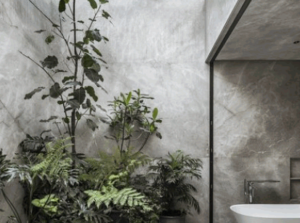
Gypsum Plaster
Gypsum plaster is a popular choice for bathrooms due to its resistance to mold, mildew, and stains, making it ideal for maintaining a clean and hygienic space.
Its stain-repellent properties ensure that any spills or splashes can be easily wiped away, keeping the bathroom looking fresh and spotless.
When paired with tiled spaces, gypsum plaster offers a sleek and seamless finish, enhancing the overall aesthetic appeal of the room.
The ease of maintenance that gypsum plaster provides is another advantage for busy households, requiring minimal effort to keep the walls looking pristine.
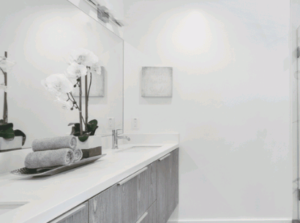
Lime Plaster
Lime plaster offers an eco-friendly and aesthetically pleasing option for bathroom walls, combining durability with a traditional design aesthetic.
This natural material is not only sustainable but also breathable, preventing mold and mildew growth in damp bathroom environments. Its traditional appeal adds a touch of charm and character, creating a warm and inviting atmosphere. Lime plaster also allows for a versatile design approach, as it can be polished to a smooth finish or textured for a more rustic look.
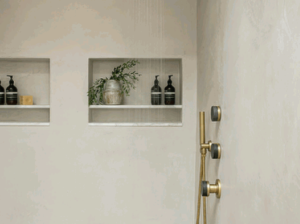
Acrylic Plaster
Acrylic plaster is a modern choice for bathrooms, known for its sleek finish and ability to create accent walls that enhance the aesthetic appeal of the space.
Its versatility in crafting unique accent walls allows homeowners to play with textures and colors, adding depth and character to their bathroom design. This innovative material seamlessly integrates into various room styles, whether in a minimalist, contemporary setting or a more traditional, classic ambiance. The sleek appearance of acrylic plaster brings a touch of sophistication and modernity to bathroom spaces, making them stand out with a refined and polished look.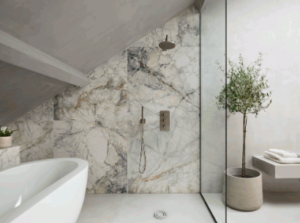
Which Type Of Plaster Is Best For Bathrooms?
The best type of plaster for bathrooms should exhibit water resistance, mold resistance, and damp-proof characteristics to ensure longevity and maintain a hygienic environment.
In bathroom settings, the issue of moisture is particularly crucial as it can lead to the deterioration of traditional plasters over time. Water-resistant plasters, such as those specifically formulated for wet environments, provide a protective barrier against water penetration, minimizing the risk of structural damage.
On the other hand, mold-resistant plasters are designed to inhibit the growth of mold and mildew, contributing to a healthier indoor air quality. These plasters are particularly beneficial in spaces like bathrooms where high humidity levels can create an environment conducive to mold growth.
Damp-proof plasters offer an additional layer of protection by preventing moisture from seeping through walls and causing potential issues like dampness and efflorescence. They help maintain the structural integrity of the walls and ensure a dry and comfortable space.
When considering plaster options for bathrooms, techniques such as tadelakt, a waterproof plastering method originating from Morocco, and Venetian plaster, known for its luxurious appearance and water-resistant properties, can be employed to achieve both aesthetic appeal and functionality.
Water-Resistant Plaster
Water-resistant plaster is essential for bathroom walls, especially in areas prone to moisture, offering protection against water damage and maintaining the integrity of the surfaces.
One popular technique used for creating water-resistant plaster in bathrooms is tadelakt, a traditional Moroccan method that involves using lime plaster mixed with black soap and finished with a special rubbing technique.
Applying water-resistant plaster is crucial in bathrooms as it helps to prevent mold, mildew, and structural damage caused by continuous exposure to water. By ensuring that the walls are properly sealed and protected, homeowners can enjoy a durable and long-lasting solution for their bathroom walls.
Mold-Resistant Plaster
Mold-resistant plaster is crucial for maintaining clean and hygienic bathroom surfaces, preventing the growth of mold and mildew that can compromise the health and aesthetics of the space.
By incorporating mold-resistant plaster in your bathroom, you not only ensure a healthier environment but also prolong the longevity of your walls and ceilings. The use of techniques like Venetian plaster not only adds a touch of elegance to your bathroom but also acts as a protective barrier against mold. Regular maintenance, such as wiping down surfaces and fixing leaks promptly, contributes significantly to the prevention of mold growth, ultimately saving you time and money on potential repairs.
Damp-Proof Plaster
Damp-proof plaster is an excellent choice for bathrooms due to its durability, ability to resist moisture, and capacity to maintain a textured finish even in high-moisture spaces.
One of the key advantages of using damp-proof plaster in bathrooms is its remarkable durability, which ensures that the walls can withstand constant exposure to moisture without deteriorating over time. This durability is especially crucial in spaces like shower walls where water splashes and humidity levels are high.
The textured appearance of damp-proof plaster adds a touch of elegance to the bathroom, creating a visually appealing aesthetic that enhances the overall ambiance of the space. Whether it’s a smooth Marmorino finish or a rugged look achieved through fiber-reinforced plaster, the versatility of these techniques allows for customization to suit various design preferences.
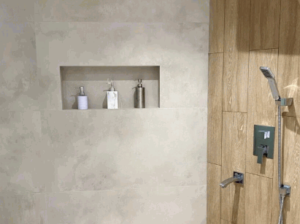
What Are The Benefits Of Using The Right Type Of Plaster In Bathrooms?
Using the appropriate type of plaster in bathrooms offers benefits such as preventing water damage, resisting mold and mildew growth, and enhancing the overall aesthetics of the space.
One of the key advantages of choosing the right bathroom plaster is its ability to form a protective barrier that helps prevent water seepage and resultant damage to the walls and structures in the bathroom. This characteristic is particularly crucial in areas prone to high humidity and moisture, such as bathrooms.
Additionally, the mold and mildew resistance properties of the proper plaster not only contribute to a healthier indoor environment by inhibiting the growth of harmful microorganisms but also aid in maintaining the cleanliness and longevity of the bathroom surfaces.
The choice of the appropriate plaster can significantly impact the visual appeal of the space, allowing for various decorative finishes like Marmorino and Stencil to be applied, enhancing the aesthetic charm and personalizing the ambiance of the bathroom.
Prevents Water Damage
Proper bathroom plaster helps prevent water damage by creating a protective barrier against moisture infiltration, reducing the need for frequent maintenance and upkeep.
A well-maintained bathroom with effective plaster application not only safeguards the structural integrity of the walls but also contributes to a healthier indoor environment by minimizing the risk of mold and mildew growth. To ensure long-lasting protection, regular inspection and repair of any cracks or damage in the plaster are essential to prevent water from seeping into the walls.
Sealing seams and joints with waterproof materials is also crucial in maintaining a watertight environment. This step not only prevents water leaks but also adds an extra layer of defense against water damage, extending the lifespan of the bathroom walls and fixtures. By taking proactive measures to prevent water damage, homeowners can preserve the aesthetics and functionality of their bathrooms for years to come.
Take a look: How To Repair Plaster Walls
Resists Mold And Mildew Growth
Choosing mold-resistant plaster inhibits mold and mildew growth, ensuring surfaces remain clean, stain-free, and durable even in high-moisture conditions.
In terms of bathroom plaster, the importance of mold and mildew resistance cannot be overstated. Preventing mold and mildew growth not only maintains the aesthetic appeal of the space but also plays a crucial role in promoting a healthy environment. By opting for materials specifically designed to deter mold and mildew proliferation, homeowners can enjoy long-lasting surfaces that are not only easy to clean but also resistant to unsightly stains that can mar the appearance of the bathroom.
Improves Aesthetics
Using the right type of plaster enhances the aesthetics of a bathroom, offering opportunities to introduce color, texture, and finishes that complement the design elements like sinks and accent walls.
When considering plaster for a bathroom, it is crucial to select a material that not only looks visually appealing but also functions effectively in a humid environment. Opting for a light-colored plaster can help create an airy and spacious feel, while darker hues can add depth and drama to the space.
Textures play a key role in adding dimension to the walls; smooth finishes can exude a contemporary vibe, whereas textured plasters like Spatula add a luxurious touch. Mixing different finishes can create a visually stimulating contrast, enhancing the overall design cohesion.
Techniques like Spatulato are particularly popular for achieving unique and stylish surfaces in bathrooms. By expertly applying this technique, one can create a sophisticated and modern look that elevates the overall aesthetics of the space.
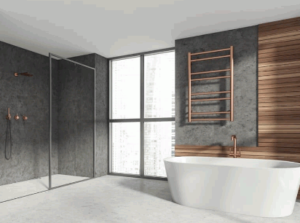
How To Choose The Right Type Of Plaster For Your Bathroom?
Selecting the appropriate type of plaster for your bathroom involves considering factors such as location, water and mold resistance, durability, and longevity, and consulting with a professional plasterer for expert guidance.
When choosing bathroom plaster, take into account the specific conditions of the space where it will be applied. Ensuring that the plaster is suitable for high-moisture environments is crucial for long-term performance. Leigh Herzig and other experienced professionals can offer valuable insights on the most suitable materials and application techniques for your unique needs. It’s also important to discuss your budget and timeframe with the plasterer to ensure a seamless renovation process.
Consider The Location Of Your Bathroom
When choosing bathroom plaster, consider the specific location of the space to assess water exposure levels, installation requirements, and the suitability of different plaster options.
For bathrooms with high moisture levels, such as those close to showers or tubs, selecting a water-resistant plaster becomes crucial to prevent damage and ensure longevity.
The position of the bathroom within the house can also impact the plaster choice; for instance, bathrooms located on upper floors might require additional considerations due to potential structural shifts.
When dealing with intricate bathroom layouts, opting for plaster types like Marmorino provides not only durability but also the versatility to create unique textures enhancing the overall aesthetic appeal of the space.
Look For Water And Mold Resistance
Prioritize water and mold-resistant qualities in bathroom plaster to ensure long-term durability, minimal maintenance, and a hygienic design that addresses potential issues like mold growth and water damage.
When selecting plaster for a bathroom, it’s essential to consider its ability to withstand constant exposure to moisture. Opting for water and mold-resistant plaster not only safeguards your walls against damage but also contributes to a healthier bathroom environment. Integrating such durable plaster can save you time and money in the long run by reducing the need for frequent repairs and replacements. Sealed seams and joints play a crucial role in preventing water infiltration, ensuring that your bathroom remains free from mold and structural weakening caused by moisture. By focusing on these attributes, you can create a bathroom that not only looks great but also lasts for years to come.
Check For Durability And Longevity
Assess the durability and longevity of different plaster options for bathrooms, considering factors like textured finishes, cement-based formulations, and maintenance requirements to ensure lasting performance.
When evaluating plaster choices for bathroom applications, it’s crucial to prioritize durability and longevity to guarantee a lasting investment. Textured surfaces play a pivotal role in enhancing the resilience of the plaster, providing added protection against wear and tear in high-moisture environments. One of the key advantages of opting for a cement-based plaster is its renowned longevity, making it a reliable choice for long-term durability.
Proper maintenance practices, such as regular cleaning and sealing, are essential in upholding the integrity of the plaster over time, safeguarding it against potential damage and deterioration.

Consult A Professional Plasterer
Seek advice from a professional plasterer when selecting materials for your bathroom, as their expertise can guide you on the best techniques, products, and applications for achieving optimal results.
Consulting with an experienced plasterer not only ensures that you make informed decisions about your bathroom renovation but also helps in avoiding costly mistakes. These experts, like Bodie Fou, bring a wealth of knowledge on different plastering materials and their suitability for various surfaces. They can provide valuable insights into the latest trends in bathroom design, ensuring that your project aligns with both style and functionality. By tapping into their expertise, you can customize your project to meet your specific requirements, ultimately enhancing the overall outcome.

